Menu
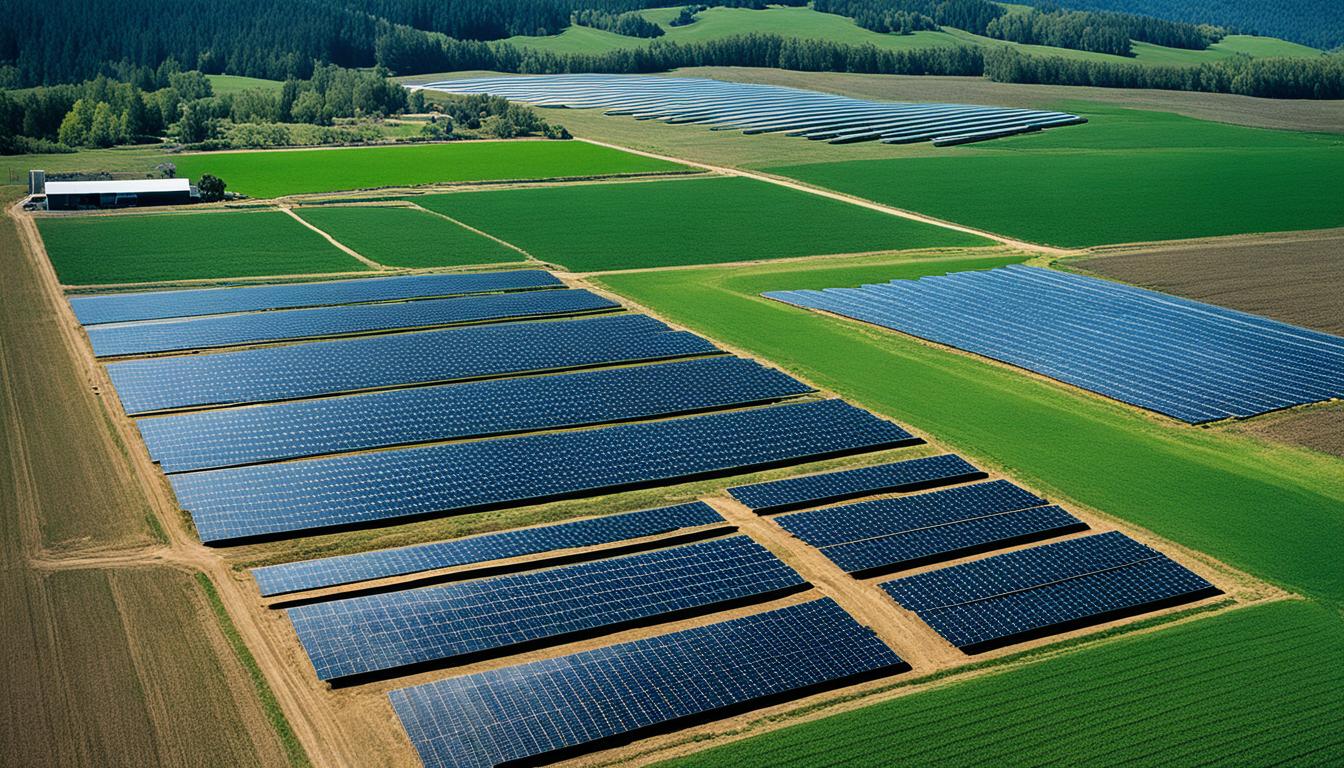
Did you know that over 24% of the Common Agricultural Policy (CAP) budget went to rural development from 2014 to 2020? That’s about 99.59 billion € spent to promote green farming. In Bavaria, half of all farm businesses joined eco-schemes in 2020. This shows a big effort in dealing with strict environmental rules.
This article looks at how farmers in northern Ghana are managing with harsh climates. They are facing challenges like severe droughts and heavy floods. These farmers are working hard to keep their farms going, despite these tough conditions.
When farmers adjust to meet environmental laws, they can sometimes get into debt. This happens because the climate is changing, causing farming to be unpredictable. Small farmers feel this burden more. Their changes to their farms can be the answer to survival but can also be very costly.
Sustainable farming is vital in today’s agriculture. It ensures high-quality food production while looking after the environment, supports the economy, and is fair to all. It means farming in a way that’s good for nature, farmers, their workers, and the local area, and keeps all animals safe.
Sustainable farming balances the health of the earth, making money, and people’s well-being. Things like using tiny living organisms for fertilisers and pest control instead of chemicals, help our fields stay healthy without harming nature. The growth of these new practices worldwide shows we can farm to feed everyone without harming the planet.
Environmental rules play a big part in farming the right way. In the EU, most people worry they are hurting the planet when they buy things. This made the EU strengthen its green farming laws. Looking at France, from 2010 to 2019, the number of pig farms dropped while bigger eco-friendly farms grew. This shows more and more farms in France are choosing greener ways to work thanks to these rules.
| Year | Statistic |
|---|---|
| 1998 | 44% of French consumers bought at least one organic product in the past six months |
| 2010 | 6456 farms specialising in pork; 52% located in Brittany |
| 2016 | 56% of French fattening pigs located in Brittany |
| 2019 | 32 recognised Producer Organisations in the pig sector representing 90% of French production |
Science shows that making and following green farming rules is key for a healthy planet. By constantly improving and breaking down barriers, these rules can help farming fight climate change. This means we can grow food in a way that’s good for the whole world.
Climate change is a big problem for farming. It hits small farmers hard, causing droughts and floods. These challenges make growing food difficult. It’s urgent for farmers to find new ways to deal with this. The drop in crop yields is a serious issue because of these problems.
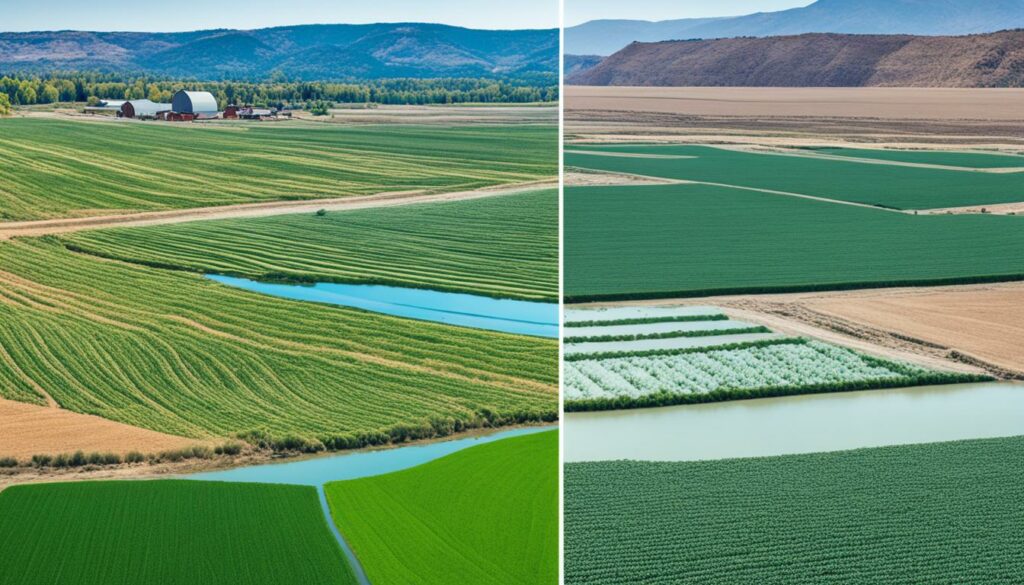
In places like Wisconsin and Florida, crop harvests have been much smaller. Adaptation Resources for Agriculture found this in their studies. Florida, known for big crop values, faces risks due to this. A $7.8 billion industry shouldn’t lose any harvests.
Adapting to climate change is hard. Small farmers need solid plans to deal with more bad weather. Indiana and Puerto Rico are looking into ways to improve their farms. They’re trying to grow stronger by planting a variety of crops.
LAWS are changing to help farming be more sustainable. This includes supporting special crops in California. Teaching farmers about climate and fair practices is helping too. These efforts are key to helping farmers stand up to climate change.
Looking at places like Wisconsin and Texas shows the need for smart plans. From dairy farms to various crops, everyone is trying to stay afloat. It’s clear that different efforts are being made to protect farming and the economy.
To fight climate change’s effects on farming, we need a smart, long-term plan. This will help keep farms productive and the environment healthy.
Farmers have found various ways to follow strict environmental laws across America. From the Midwest to Texas and Alaska, they show how to be resilient and innovative. These farms offer great case studies on adapting to new laws.
The farms include Artisan Cider Apple Orchards, Organic Dairy Farms, and more. Each one has its own challenges, like new farm laws and changing weather. They deal with problems like erosion and pests while keeping up with the rules.
The Adaptation Resources for Agriculture offer key advice. Tools like the Adaptation Workbook online help farmers all around. This way, they can tackle adaptation step by step.
“A meta-analysis of the adoption literature found that 17-25% of farmers are likely to adopt best management practices.” (Source 25)
Adoption of eco-farming is growing in Australia and the U.S. From 30-70% of farmers are using new conservation methods. In Australia, the rate is even higher, going up to 48%.
The studies also show how important it is for tribal nations to team up with farm agencies. This partnership looks at issues that matter to their people. Working together, they get stronger at dealing with problems and finding solutions.
| Region | Type of Farm | Adaptation Focus |
|---|---|---|
| Midwest | Organic Dairy Farm | Water Management |
| California | Specialty Crop Farm | Erosion Control |
| Texas | Poultry and Beef Farm | Pest Management |
These success stories underline how vital it is to support farmers and push for new ideas. Learning from these cases helps us understand the true impact of environment laws. It shows the diverse ways farms can grow under new rules.
Agricultural sustainability is key for policymakers today. They want farming to protect the environment. With farming covering a third of the world and 41% of the EU, enforcing green laws is vital. This helps the farming sector prepare to feed more people by 2050.
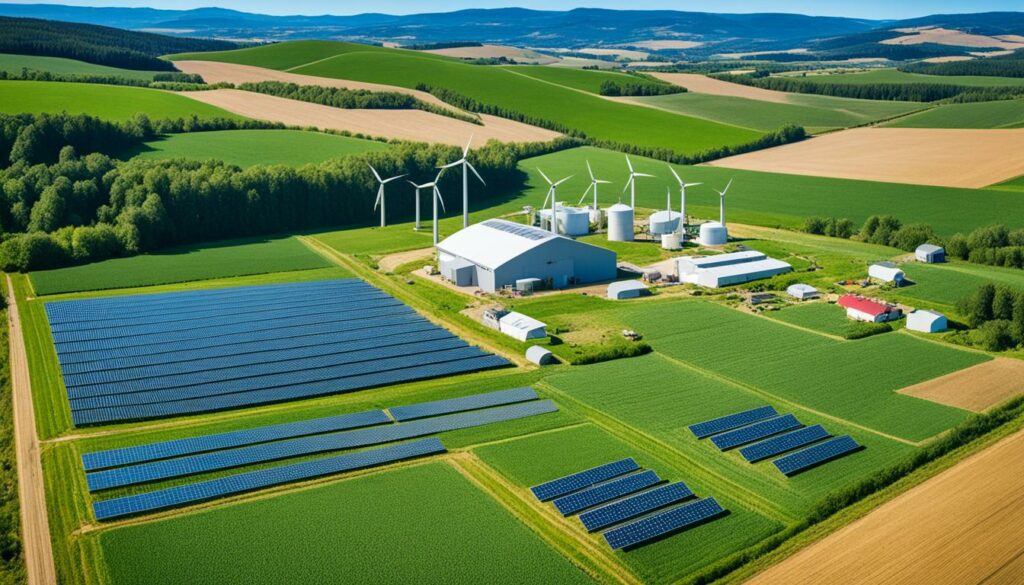
Enforcing green laws helps fight problems like soil erosion and polluted water. The EU sees soil erosion and organic matter loss as big threats. To tackle these, laws focus on multiple angles, looking at the environment and economy. This approach helps ensure farmers follow the rules closely.
Farmers follow strict rules to protect the environment. They work to keep soil healthy, save water, and protect plants and animals. Laws use both visual checks and scientific tests to make sure farmers do right. The growing use of land for non-food crops makes following these rules more important. Sustainable farming is about making sure farms work well without hurting nature.
| Soil Threat | Impact | Solution |
|---|---|---|
| Erosion | Loss of fertile topsoil | Effective soil cover |
| Loss of Organic Matter | Reduced soil fertility | Organic farming practices |
| Water Depletion | Decreased water availability | Efficient irrigation systems |
| Biodiversity Loss | Reduction in species variety | Agroforestry |
Sustainable farming is changing with new ideas mixing old ways and tech. These methods keep farming going without hurting the earth. They also help fight climate change and save our planet’s resources. The key is to use farming methods that work with nature and use clean energy.
Agroecology is at the heart of this change. It brings together nature and farming to make both stronger. A study on MDPI shows that the EU wants to invest more in this. The EU’s CAP 2014-2020 plan stresses the need for new ideas in farming.
The NARS works to make new farming technologies but can face challenges. It aims to improve farming without hurting the Earth. But it’s tough when the different parts of the farming community don’t work well together.
Using clean energy in farming is vital. Solar power, wind energy, and bioenergy lower the need for harmful fossil fuels. This is a big part of the CAP’s plan and helps tackle farming’s environmental impacts and costs.
The OECD says farming needs new ways to do things and sell its products. Using clean energy is key in these new farming methods. It helps farms last and stay profitable in the long run.
Clean energy and agroecological farming make farms stronger and more green. They are key in the battle against climate change. Continuing with these new farming methods is crucial. It will lead to farming that’s good for the Earth and the economy.
As farmers face climate change, it’s vital to know the difference between small and big changes. Incremental adaptations mean making small tweaks to what’s already done. Transformational approaches are about changing how farming’s done, bringing in completely new systems.
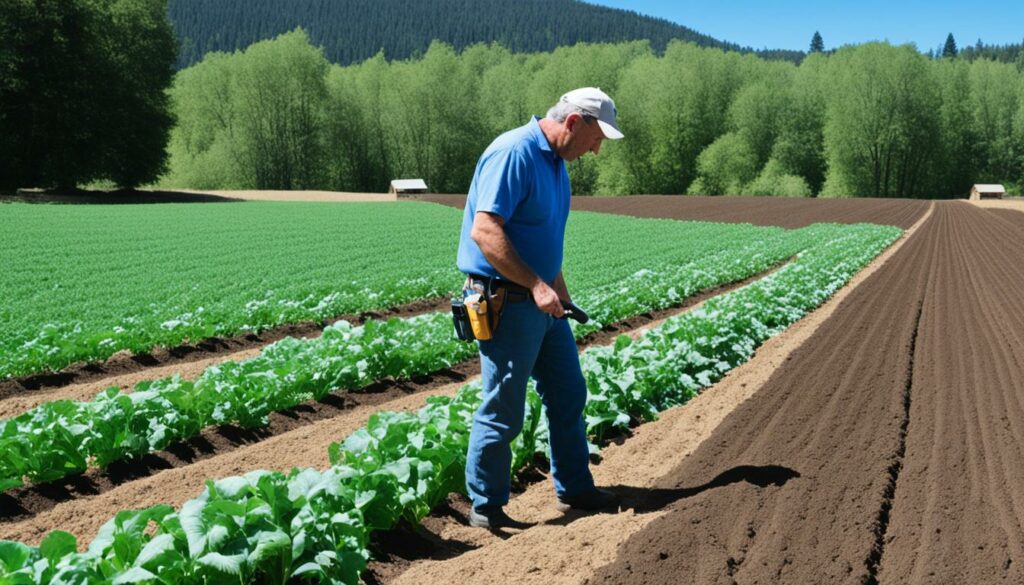
Incremental methods aim to make current ways of farming better at handling climate changes. This might mean changing when crops are planted, using plants that can cope with droughts, and being smarter with water. For example, using less water in farming in Africa has helped deal with the risks from climate changes. Yet, these small steps are often just for the growing part and might not solve the biggest problems from climate change.
Transformational farming is a big change from the usual. It could mean doing things like planting trees among crops, farming vertically, or using more renewable energy. This kind of change is usually a reaction to very serious climate problems that demand leaving old ways behind. The Sahel region is one place where farming has changed a lot to make a ‘Green Revolution’ start.
Big transformations in farming also change what goes in and what comes out. More and more farmers are focusing on being able to survive and change in the long run. This shift shows a growing interest in big, long-lasting farming changes. However, big moves like these can mean giving up old farming styles, which has its own challenges for keeping farming sustainable.
Looking at how different places respond to adapting, the bigger changes mostly happen in dry regions. This is where small changes often can’t do enough to help. In the end, small tweaks help, but the real goal is to make farming last through big climate challenges.
| Adaptation Type | Scope | Frequency |
|---|---|---|
| Incremental Adaptations | Small-scale adjustments in existing practices | High |
| Transformational Approaches | Major shifts to new farming systems | Increasing |
Climate change is causing big problems for farming. The heat is making grain shrivel, which hurts crop yields. In the next 30 years, hot days in May will increase a lot. There will also be more droughts from March to June. To fight these issues, farmers are choosing crops that can handle the changing climate. They are also using new farming methods.
Many areas are now picking crops that survive extreme weather better. The FAO says using these new crops can lessen climate change’s harm. Practices like crop rotations with legumes are doing well. They make higher yields and resist the climate better than growing just one crop. In Eastern Uganda, almost half of the small farmers now plant maize that can tolerate drought. This change came because women and men have different jobs in the fields.
New farming ways are key for dealing with climate issues. Early sowing and planting special crops at field edges are helping. They stop soil erosion and make space for different plant and animal species. Also, letting livestock roam on unused land can help enrich the soil. This makes it better and stronger. These solutions are saving money for farmers. One farm in Spain spent 5,000 € on a plan. This shows that preparing for future problems is smart. Farmers are also keeping track of how well these new methods work.
In Sub-Saharan Africa, weather shocks are shaking up agriculture. Diversification is key to stand strong. It’s about mixing crops with livestock and trees. This makes farms more productive and able to cope with change.
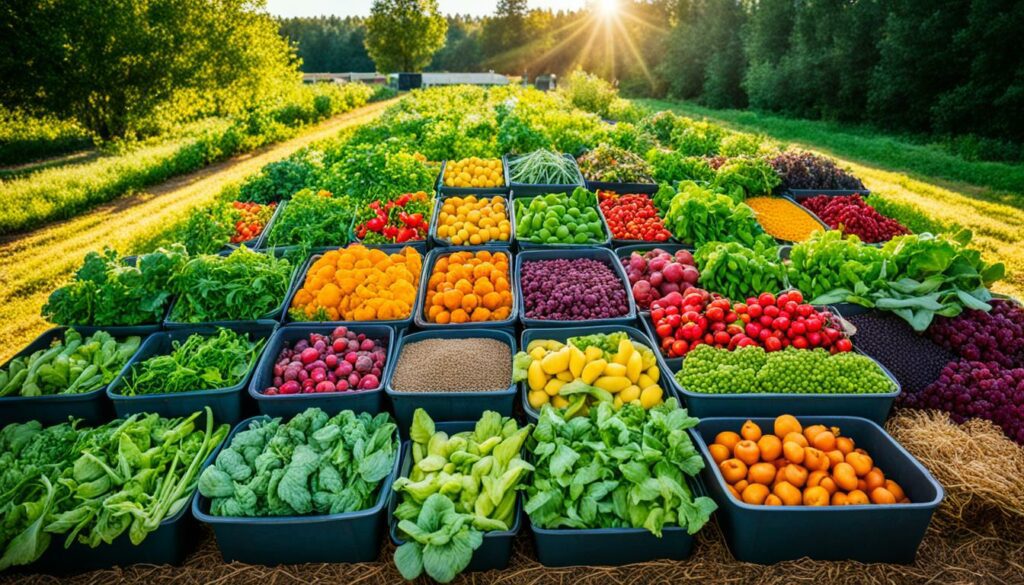
Linking animals with crops can help farms deal with climate stresses. In SSA, livestock face big challenges, like finding enough food and water. If farmers raise different animals and plants, their farms can be more resilient. Using seeds that can handle drought and planting different crops also helps.
Agroforestry and mixed farming are smart ways to mix things up. In places like Namibia, mixing animals with crops and trees brings many benefits. It helps the soil and wildlife, plus it adds profits. This means more food and money for the people there.
Climate changes are spurring farmers to try new things. Mixing crops in clever ways offers hope. But, success also needs support from family, owning things, and help from government or groups. And, farms that grow many different crops and animals usually do better.
The ASSAR project and surveys in Africa show mixing things up helps feed people better. Yet, many areas could do more to diversify their fields. Still, most farmers sell their varied crops, showing it helps them earn more.
With water scarcity on the rise, innovations in managing water are key for agriculture. These advances are more than just updates. They help us deal with climate change and ensure farms can last in the long run.
Efficient irrigation is a major innovation in water management. Drip irrigation, for example, sends precise water amounts to plant roots. This method saves water and boosts crop growth. In Albuquerque, a 14% drop in water demand since 1990 proves its success.
The city successfully slowed groundwater drawdown while maintaining water demand levels. The introduction of these efficient irrigation systems was instrumental in achieving this milestone.
Cary’s action to save around 395,000 gallons a day shows how powerful efficient irrigation can be in using less water.
Rainwater harvesting is becoming popular for managing water. It collects rain for farming, cutting the need for outside water. Gallitzin’s effort, which cut lost water by 87%, shows how well this works for farms.
| Location | Method | Outcome |
|---|---|---|
| Albuquerque | Efficient Irrigation Systems | 14% decrease in peak demand |
| Cary | Water Conservation Programme | 395,000 gallons/day saved |
| Gallitzin | Rainwater Harvesting | 87% reduction in unaccounted-for water |
| Houston | Comprehensive Conservation Programme | 7.3% reduction in water demand |
| Goleta | Water Efficiency Programme | 30% drop in district water use |
Houston’s plan, aiming for a 7.3% cut in water demand, highlights rainwater harvest’s value. These water innovations help agriculture thrive even in water-short situations. They are essential for farming’s sustainable future.
Knowing the hurdles to adapting to climate change is key, especially in places like northern Ghana. There, changes in weather over the past 30 years have made farming harder. Despite trying new crops, farmers have many challenges to face.

Problems not linked to the weather, such as lacking technology and money, stop farms from changing. In Bagri, for example, there’s a shortage of things like power and places to store crops. This makes it tough for farmers to stick to better farming methods. Also, not having enough money and tech adds to the troubles.
Challenges from the changing climate, like storms that hit more often and harder, make things even harder. Farmers try new crops, but still, they often end up with less and in debt. There’s a push to change little by little or a lot (‘incremental’ or ‘transformational’). But, whatever they pick, it must work well against the changing weather.
Problems in adjusting to climate change can be beat with joint work, moving resources, and changing rules. To make farming still work in risky places, like many developing countries, it’s clear we need to pay more attention. This means looking after places that are easily hit but find it harder to cope. Read more in detail on overcoming these hurdles here.
Financial impacts from being eco-friendly concern many in farming. Laws demand farmers to spend lots on new green practices. They must keep up, yet still make money. We’re going to look at costs, ways to get funds, and grants next.
Adjusting farming to meet green standards is costly. One study looked at 18,000 papers on green incentives’ effects. It showed that these incentives help the environment and earn money. Market-based incentives are crucial. They connect the eco and economic benefits, helping farmers change quickly.
Farmers badly need funds and grants to follow the rules. Policies target funds to people with specific needs. They aim at balancing money, environment, and society. Some incentives also push for sustainable changes.
In 2004, at the OECD Global Forum, experts shared success stories. Brazil, Australia, the Netherlands, and Indonesia talked about their systems. They use public info and financial help to make sure farmers follow the laws.
“In the long run, farmers are motivated to adopt sustainable practices due to perceived benefits for their farms or the environment,” the review concluded, underscoring the importance of linking economic benefits to promote immediate adoption.
Good policy help for farmers is key in making them adapt to strict green laws. It also helps in pushing forward ways for farming and protecting nature. In recent times, big steps have been taken. Governments and groups outside the government are working together to make farming strong against issues caused by the changing climate.
The Common Agricultural Policy (CAP) is crucial in this support. Between 2014 and 2020, it gave about €104 billion for fighting climate change. This includes cutting down harmful gas emissions and investing in ways to lock carbon. The 2023-2027 CAP makes a big promise to reach zero harmful gas emissions in the EU by 2050. It also focuses on keeping water clean, stopping soil loss, and lowering ammonia. These are important for our environment. The policy also helps in taking care of forests, following the EU’s forest plan.
Non-governmental groups are also big in providing support. They push for new and eco-friendly ways to farm through research and sharing knowledge. The iMAP programme gets different groups to work together for a better farming future. The CAP also works to help nature by things like special areas for nature and better farming that protects wildlife. This encourages farmers to use less harmful chemicals.
Numbers from the CAP show a lot of success: 82% of the efforts to follow green laws showed they worked well. Also, two-thirds of farmers feel good about these rules. And most farmers agree that fighting climate change is important. This shows people are coming together to face climate change with strong plans.
In northern Ghana, farmers are using new methods to fight climate change. They grow drought-resistant crops and change when they plant. This helps them deal with droughts and floods better.
Sustainable farming mixes new tech with old farming methods. Its aim is to keep farming good for the environment in the long run. This means using resources well and not hurting the Earth.
Rules keep farming from hurting the Earth. They help protect nature, keep different plants and animals alive, and make sure we don’t use too many resources.
Climate change messes up the weather and makes growing food harder. It causes droughts and floods more often. This can harm what farmers grow and their farms.
Farmers can do a few things to handle climate change. They can plant different crops, use better ways to water them, and learn new farming methods. This helps them deal with the changing weather.
There are rules farmers have to follow, like checking if they’re doing things right. If they break the rules, they might have to pay a fine. But, they also get help to understand and meet these regulations.
Farmers need to follow rules on water, pesticides, saving the soil, and handling waste. This is to make sure they don’t harm the environment while farming.
New ways of farming include using eco-friendly practices and clean energy. Techniques like smart watering and collecting rainwater also help. They make farming greener and more efficient.
Incremental means making small, steady changes to farm better. Transformational is a big shift to a whole new way of farming. Both help the environment in different ways.
Climate-resilient crops are tough plants bred to handle tough weather. People choose them for their ability to grow well even in bad conditions while still giving good harvests.
Mixing things up on farms, like growing crops with animals, makes farms stronger. It helps protect the soil, brings in steady money, and deals with problems better. This is farming that lasts.
Better ways to water farms include using little water and saving rain. Drip and sprinkler systems and collecting rainwater help farms use water wisely. This is good for dry times.
There are many things that make farming hard, like not enough money or access to tech. Problems such as more extreme weather also make it tough to keep farming well.
Following the green rules can cost farmers money for new tech and methods. But, there’s help available, like money from the government, to make these changes easier.
Government and other groups give farmers help, training, and money to farm better. This support is key in making farms sustainable and good for the planet.